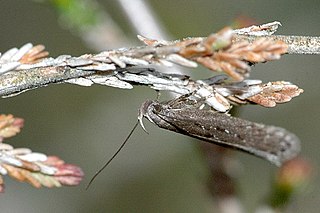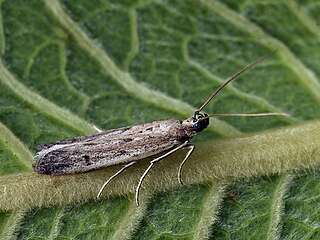
Aglossa pinguinalis, the large tabby or grease moth, is a moth in the subfamily Pyralinae. The species was first described by Carl Linnaeus in his 1758 10th edition of Systema Naturae. The dark-hued larvae feed on animal fats,

Dioryctria abietella is a moth of the family Pyralidae. It is found in Europe.

Ephestia elutella, the cacao moth, tobacco moth or warehouse moth, is a small moth of the family Pyralidae. It is probably native to Europe, but has been transported widely, even to Australia. A subspecies is E. e. pterogrisella.

Pempelia palumbella is a moth of the family Pyralidae. It is found in Europe.

Phycita roborella is a moth of the family Pyralidae. It is – under its junior synonym Tinea spissicella – the type species of its genus Phycita, and by extension of the subfamily Phycitinae.

Nephopterix angustella is a moth of the family Pyralidae described by Jacob Hübner in 1796. It is found in Europe.

Neofaculta ericetella is a moth of the family Gelechiidae. It is found in Europe and Asia Minor.

Homoeosoma nebulella, the Eurasian sunflower moth, is a moth of the family Pyralidae. It is found in Europe, Russia, Anatolia, the Middle East and West Africa. The wingspan is 20–27 mm.The forewings are pale whitish ochreous, tinged with grey and sprinkled with dark grey, towards costa suffused with whitish ; first line indicated by two blackish dots, upper more remote from base; second faintly darker-edged, usually preceded by a dark fuscous subdorsal dot; two blackish transversely placed discal dots. The hindwings are subhyaline, fuscous-tinged, the veins and termen fuscous. Larva dull greenish-yellow dorsal and broader subdorsal lines dull purple; spiracular interrupted, double, dull purple; head brown: in flower-heads of Carduus

Pyla fusca is a snout moth of the subfamily Phycitinae and inhabits the Holarctic. It is distinct from the other species of the genus Pyla, which are only found in North America, and has been proposed for separation in a monotypic genus Matilella. Considering the insufficient knowledge of Phycitinae, this may be warranted, and eventually relatives of this specimens might be discovered in the Old World, or it might turn out to be a cryptic species complex. On the other hand, its separation might render Pyla paraphyletic, in which case it would not be warranted. More research is required to resolve this question.

Homoeosoma nimbella is a moth of the family Pyralidae. It is found in Europe.

The lobster-clawed moth is a moth of the family Gelechiidae. It is found in most of Europe, except for the Iberian Peninsula and most of the Balkan Peninsula. In the east, the range extends to Siberia and Taiwan.

Pempeliella ornatella is a moth of the family Pyralidae described by Michael Denis and Ignaz Schiffermüller in 1775. It is found in most of Europe, east to the Ural, Siberia, central Yakutia and Kyrgyzstan.

Ectoedemia intimella is a moth of the family Nepticulidae which is found in Europe. It flies in June and July and the larva mine the leaves of willows from July to November.

Aristotelia ericinella is a moth of the family Gelechiidae. It is found in most of Europe, except most of the Balkan Peninsula.

Cryptoblabes bistriga is a species of snout moth in the genus Cryptoblabes. It was described by Adrian Hardy Haworth in 1811. It is found in most of Europe, except Portugal, parts of the Balkan Peninsula and Ukraine.

Acrobasis advenella is a species of snout moth in the genus Acrobasis. It was described by Johann Zincken in 1818 and is found in most of Europe. They have an oligophagous diet primarily feeding on plants from the Rosaceae family including the black chokeberry. They cause significant damage to organic chokeberry farming, due to their widespread impact on the quality and quantity of the black chokeberry plants.

Delplanqueia dilutella is a species of moth in the family Pyralidae. It was described by Michael Denis and Ignaz Schiffermüller in 1775. It is found in most of Europe, east to Russia, Turkey, Iran and Mongolia.

Phycitodes binaevella is a species of snout moth described by Jacob Hübner in 1813. It is found in most of Europe, Asia Minor, Lebanon and the Palestinian Territories.

Scrobipalpa obsoletella, the summer groundling, is a moth of the family Gelechiidae. It is found in most of Europe, Turkey, the Caucasus, from Iran to Asian Russia (Transbaikal) and Mongolia. It has also been recorded from New Zealand, South Africa and North America, where it is probably an introduced species. The habitat consists of coastal salt marshes and sandy beaches.
Ardozyga phasianis is a species of moth in the family Gelechiidae. It was described by Edward Meyrick in 1904. It is found in Australia, where it has been recorded from New South Wales, Victoria and Tasmania.



















